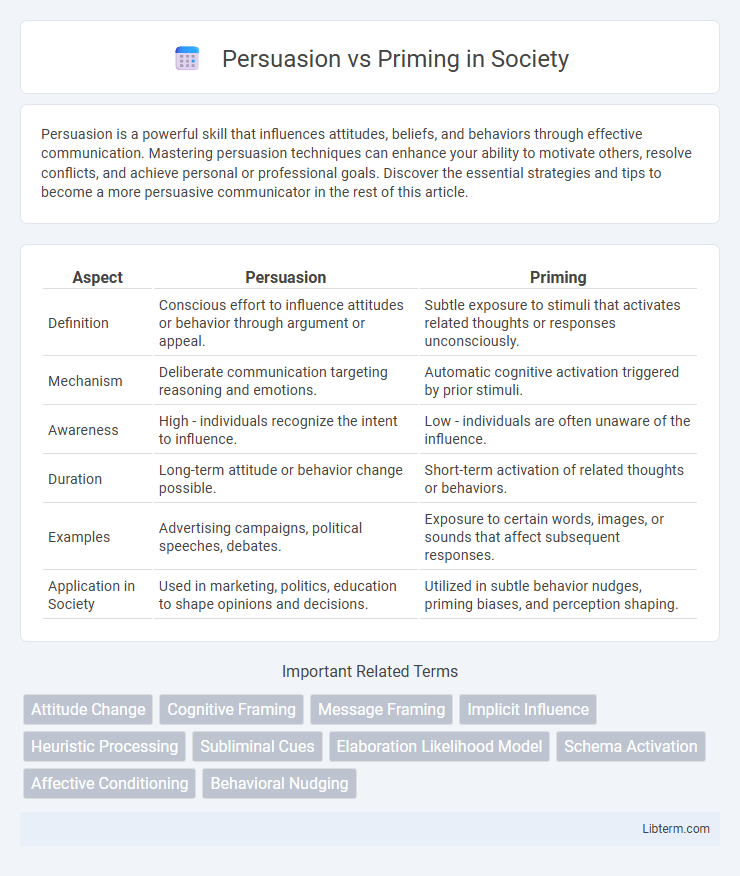Persuasion is a powerful skill that influences attitudes, beliefs, and behaviors through effective communication. Mastering persuasion techniques can enhance your ability to motivate others, resolve conflicts, and achieve personal or professional goals. Discover the essential strategies and tips to become a more persuasive communicator in the rest of this article.
Table of Comparison
| Aspect | Persuasion | Priming |
|---|---|---|
| Definition | Conscious effort to influence attitudes or behavior through argument or appeal. | Subtle exposure to stimuli that activates related thoughts or responses unconsciously. |
| Mechanism | Deliberate communication targeting reasoning and emotions. | Automatic cognitive activation triggered by prior stimuli. |
| Awareness | High - individuals recognize the intent to influence. | Low - individuals are often unaware of the influence. |
| Duration | Long-term attitude or behavior change possible. | Short-term activation of related thoughts or behaviors. |
| Examples | Advertising campaigns, political speeches, debates. | Exposure to certain words, images, or sounds that affect subsequent responses. |
| Application in Society | Used in marketing, politics, education to shape opinions and decisions. | Utilized in subtle behavior nudges, priming biases, and perception shaping. |
Introduction to Persuasion and Priming
Persuasion involves intentionally influencing attitudes, beliefs, or behaviors through communication strategies that appeal to logic, emotions, or credibility. Priming activates specific concepts or associations in the mind unconsciously, shaping responses and judgments without direct persuasion. Both processes impact decision-making, but persuasion relies on conscious engagement while priming operates through subtle, automatic cognitive cues.
Defining Persuasion
Persuasion is the deliberate process of influencing an individual's attitudes, beliefs, or behaviors through argumentation, reasoning, or emotional appeal. Unlike priming, which involves subconscious exposure to stimuli that affects subsequent responses, persuasion actively engages cognitive and emotional mechanisms to achieve a specific outcome. Key components of persuasion include message source credibility, message content, and audience characteristics.
Defining Priming
Priming is a psychological phenomenon where exposure to a stimulus influences a person's subsequent thoughts, feelings, or behaviors without conscious awareness. It operates by activating specific associations in memory, making related concepts more accessible and shaping responses in various contexts. Unlike persuasion, priming works subtly and indirectly, impacting automatic cognitive processes rather than deliberate attitude change.
Core Differences Between Persuasion and Priming
Persuasion involves intentionally influencing attitudes or behaviors through communication strategies, appealing to logic, emotion, or credibility to achieve a conscious change. Priming, in contrast, activates underlying associations or memories unconsciously, subtly shaping responses without direct argument or awareness. The core difference lies in persuasion's deliberate intent and explicit messaging versus priming's automatic, implicit influence on cognition and behavior.
Psychological Mechanisms Behind Persuasion
Persuasion operates through psychological mechanisms such as cognitive dissonance reduction, where individuals change attitudes to align with new information, and the elaboration likelihood model, which describes central and peripheral routes of processing persuasive messages. It also leverages social proof and authority cues to influence behavior by altering belief systems and emotional responses. These mechanisms enhance message acceptance by engaging both rational evaluation and subconscious biases.
Psychological Mechanisms Behind Priming
Priming operates through unconscious psychological mechanisms by activating specific mental associations and neural pathways, influencing automatic cognitive responses and behaviors. Exposure to a stimulus can nonconsciously adjust perception, memory retrieval, and decision-making by making related concepts more accessible in the brain. This implicit process differs from persuasion, which typically involves conscious attitude change through argumentation or deliberate influence.
Practical Examples of Persuasion in Daily Life
Persuasion in daily life often manifests through advertising campaigns that use emotional appeals to encourage consumer purchases, such as a commercial highlighting family happiness linked to a specific brand. Political speeches employ persuasive techniques by presenting compelling arguments and relatable anecdotes to influence voter opinions and behaviors. Workplace managers persuade employees by outlining benefits and incentives to adopt new policies or improve productivity, demonstrating practical applications of persuasion beyond mere information delivery.
Practical Examples of Priming in Daily Life
Priming influences behavior by exposing individuals to specific stimuli that subconsciously trigger related responses, such as seeing the word "yellow" making someone more likely to recognize the word "banana" quickly. In daily life, retail environments use priming by playing upbeat music to encourage longer shopping durations and increased spending. Social media platforms prime users by displaying tailored content that shapes attitudes and behaviors without overt persuasion attempts.
Impact of Persuasion vs Priming in Marketing
Persuasion in marketing directly influences consumer decisions by presenting compelling arguments and emotional appeals to shape attitudes and behaviors. Priming subtly activates specific associations or memories in consumers' minds to unconsciously guide their preferences and purchasing choices. The impact of persuasion tends to produce more immediate and explicit responses, while priming fosters longer-term brand recall and implicit behavioral changes.
Choosing the Right Strategy: Persuasion or Priming
Choosing the right strategy between persuasion and priming depends on the desired impact and context. Persuasion involves overt communication aimed at changing attitudes or behaviors through logical arguments and emotional appeals, effective in situations requiring conscious decision-making. Priming subtly influences responses by activating related concepts in memory, making it ideal for shaping automatic, unconscious behavior without direct awareness.
Persuasion Infographic

 libterm.com
libterm.com